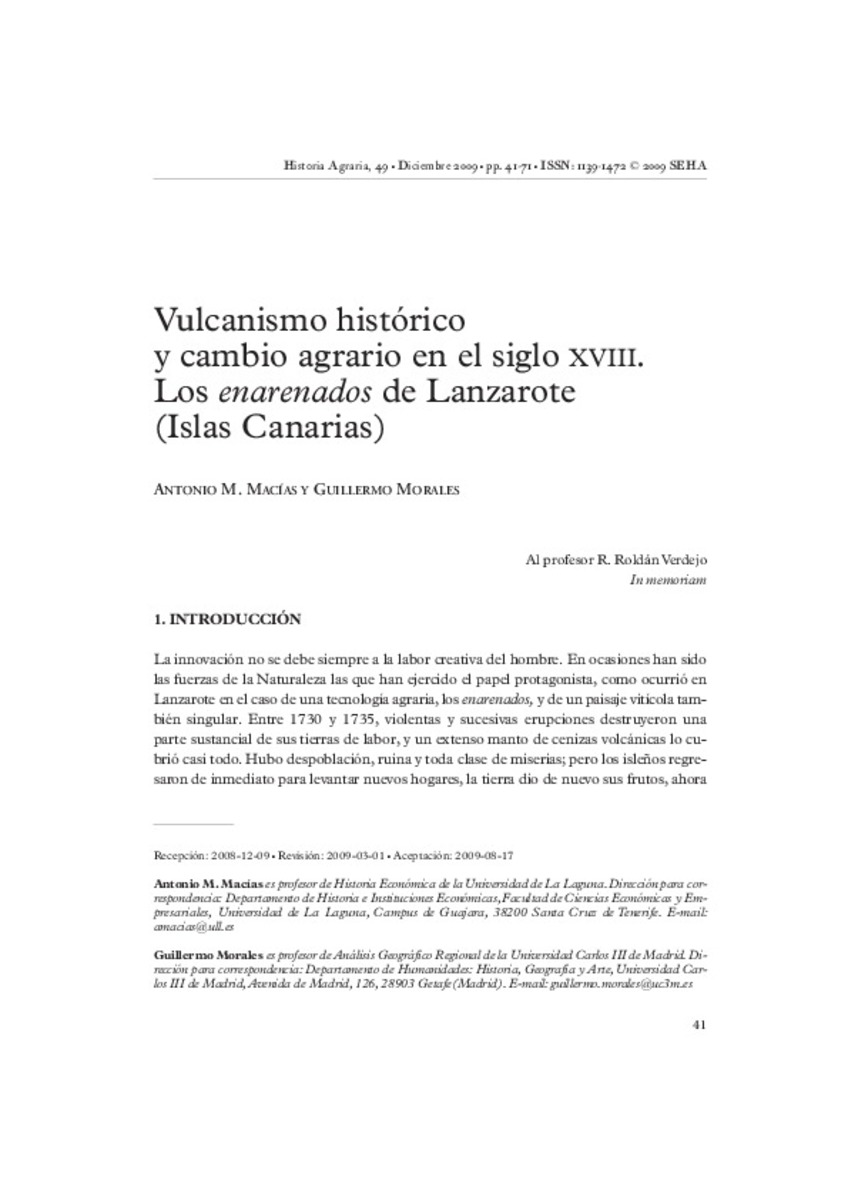Mostrar el registro sencillo del ítem
Vulcanismo histórico y cambio agrario en el siglo XVIII. Los ‘enarenados’ de Lanzarote (Islas Canarias).
| dc.contributor.author | Macías, Antonio M. | |
| dc.contributor.author | Morales, Guillermo | |
| dc.date.accessioned | 2016-02-05T11:27:32Z | |
| dc.date.available | 2016-02-05T11:27:32Z | |
| dc.date.issued | 2009-12 | |
| dc.identifier.issn | 1139-1472 | |
| dc.identifier.uri | http://hdl.handle.net/10234/148770 | |
| dc.description.abstract | Este artículo estudia el cambio agrario ocurrido en Lanzarote después de las erupciones volcánicas de 1730-1735. Sus fuentes principales son los recuentos de población y el impuesto decimal. La isla carece de recursos hídricos y la aridez es extrema; los isleños se ocupaban del cereal y de la ganadería extensiva, y eran frecuentes las migraciones en los años de sequía. El cambio agrario inducido por los volcanes transformó este modelo agropecuario. Las lavas destruyeron una parte del terrazgo y el resto quedó cubierto con una gruesa capa de arena volcánica (lapilli); pero gracias a su efecto higroscópico, determinadas plantas reverdecieron de nuevo y con mayor vigor. Había nacido el enarenado natural. Los insulares se aplicaron a desarrollar esta técnica, que hizo posible el cultivo de especies (vid, maíz, patata) hasta entonces muy limitado por la escasez hídrica. | ca_CA |
| dc.description.abstract | This paper studies the agrarian change occurred in Lanzarote after the volcanic eruptions in 1730‐1735. Population censuses and tax records are the main sources. This island lacks in water resources and is extremely arid. Its islanders grow cereal and practice extensive cattle farming, and migrations were frequent in drought years. The agrarian change caused by the volcanoes transformed this land management model. The lavas destroyed a part of the arable soil and the rest was covered by a thick layer of volcanic sand (lapilli) which, thanks to its hygroscopic effect, helped certain plants sprout again and grow more vigorously. Natural enarenado had come into being. The islanders proceeded to develop this technique, what allowed them to cultivate species (vine, corn, potato) that had previously been severely limited by the dry terrain. | ca_CA |
| dc.format.extent | 30 p. | ca_CA |
| dc.format.mimetype | application/pdf | ca_CA |
| dc.language.iso | spa | ca_CA |
| dc.publisher | Sociedad Española de Historia Agraria (SEHA) | ca_CA |
| dc.relation.isPartOf | Historia agraria: Revista de agricultura e historia rural nº 49, p. 41-71 | ca_CA |
| dc.rights.uri | http://rightsstatements.org/vocab/CNE/1.0/ | * |
| dc.subject | productividad agrícola | ca_CA |
| dc.subject | tecnología agraria | ca_CA |
| dc.subject | volcanología | ca_CA |
| dc.subject | Islas Canarias | ca_CA |
| dc.subject | Lanzarote | ca_CA |
| dc.subject | agricultural productivity | ca_CA |
| dc.subject | agrarian technology | ca_CA |
| dc.subject | vulcanology | ca_CA |
| dc.subject | Canary Islands | ca_CA |
| dc.title | Vulcanismo histórico y cambio agrario en el siglo XVIII. Los ‘enarenados’ de Lanzarote (Islas Canarias). | ca_CA |
| dc.type | info:eu-repo/semantics/article | ca_CA |
| dc.subject.jel | N33 | ca_CA |
| dc.subject.jel | N53 | ca_CA |
| dc.subject.jel | Q16 | ca_CA |
| dc.subject.jel | Q13 | ca_CA |
| dc.rights.accessRights | info:eu-repo/semantics/openAccess | ca_CA |
| dc.relation.publisherVersion | http://historiaagraria.com/info_articulo.php?id=492 | ca_CA |







